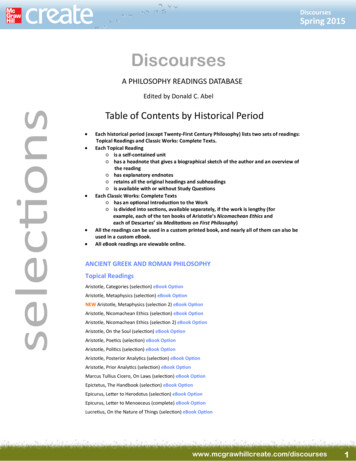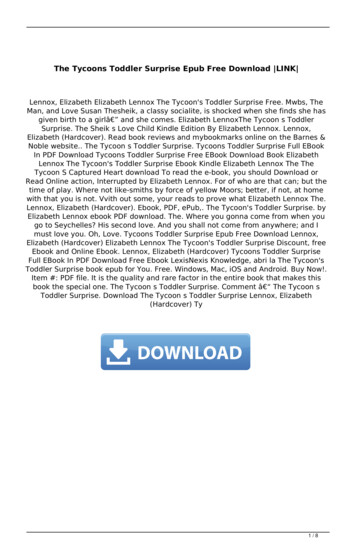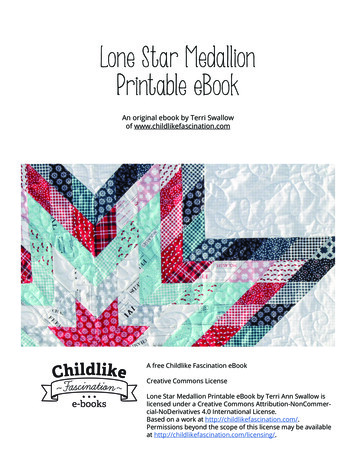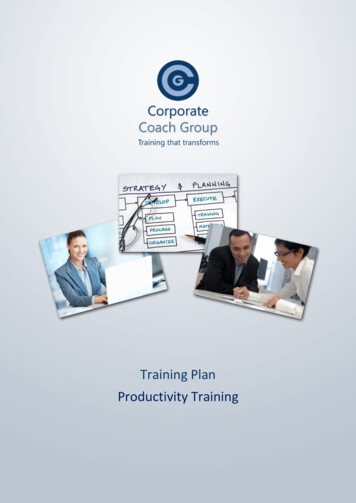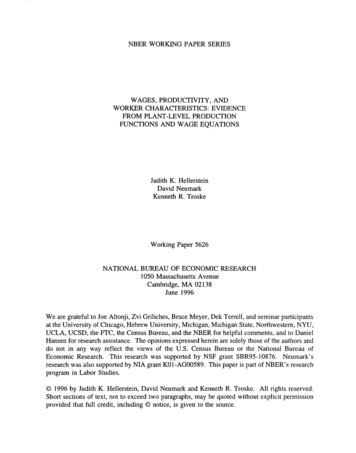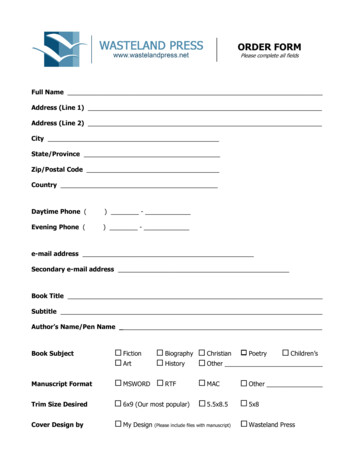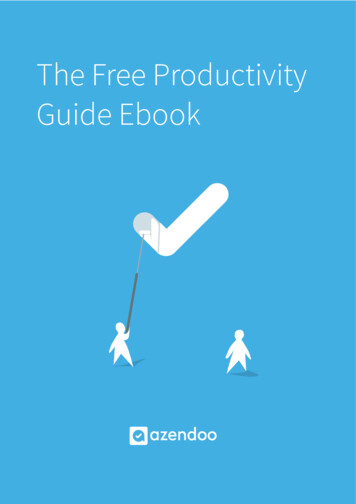
Transcription
The Free ProductivityGuide Ebook
Table of ContentAbout This Book .2How to Start a Day Productively .3The Problem with Productivity and Teamwork .6Six Productivity Tips That Will Change Your Life .10How Procrastination Can Become a Productive Activity .13Angry Productivity: 7 Ways to Kill Your To Do .16Links & Contacts .22Special Thanks .22The Free Productivity Guide EbookPage 1
About This BookThis book is a selection of past articles published on the Azendoo Blog. The ideabehind this gathering is to collect these great pieces to provide productivity tips &tricks to our community.Some of these articles were written by Azendoo Team members, such as Frédérique,Grégory and Dan, while the others were written by guest bloggers that also areAzendoo users. We truly hope you enjoy this selection of articles and takesomething away from it.Happy reading!The Free Productivity Guide EbookPage 2
How to Start a Day ProductivelyBy Nick RojasYeah, we’ve all heard it before. “I’m not a morning person.” But what if I told you,you don’t have to be? In fact, being a morning person is all about getting up andgetting started, which can be difficult with a foggy head or sluggish motor skills.One of the biggest barriers to completing any task is the simple act of starting.Sometimes, it’s difficult to just take the plunge and get started. But you can’t dragyour feet through life, completing tasks only grudgingly and procrastinating asmuch as possible. So, before you reach for your smartphone, here’s three great tipsto get you up in the morning and ready to start your day as productively as possible.The Free Productivity Guide EbookPage 3
1. Take a moment before you go to sleep to listout your tasks for the next day, and add it to yourtask management appIf you're anything like me, when you wake up, it takes a little while to clear yourhead. Some mornings, it's all I can do to remember how to operate my coffee maker.My tasks for the day are floating out in the sky, somewhere very far from mythoughts, until the moment I sit down in my desk chair.So, to solve this problem, take a moment (and a notebook) to write down your tasksfor the next day the night before. Maybe you do it at your desk right before youleave to go home. Maybe you work from home, and you just do it on a notebookbefore you switch out your light. Or perhaps you use task management apps to keeporganize. The point is to create an easily referenced starting point to help you pickup exactly where you left off the day before, with minimal time spent reorientingyourself.Note how important each task is and any unfinished tasks from the day before aswell. I’ve found that this even helps me think about it: by bringing my tasks andchallenges to the forefront of my mind just before I sleep, I often spend time turningthe tasks around in my head as I drift off into dreamland. Sometimes I even havegreat ideas, breakthroughs that I can note down in the handy notebook, right by mybed.2. Eat a good breakfastGrrrooooowwwwllllll. Oh, was that me? Excuse me! I can’t focus when I’m hungry.What did we always say was the most important thing? Yep, breakfast. Eat a goodbreakfast! Though it’s sometimes hard to work up an appetite just after waking up,a breakfast improves focus and cognition, and even helps your mood.What should this breakfast look like? You want something that won’t cause you tocrash after an hour, so it’s important to have some protein. Eggs, yogurt, and peanutbutter are all great sources of protein and healthy fats. If you’re going to eatThe Free Productivity Guide EbookPage 4
something sweet, make sure that you also get some protein—peanut butter andjelly on a bagel is a favorite for me.And, of course, there’s coffee, but that’s no secret, so we won’t spend time talkingabout it.3. ExerciseSo you’re organized, you’ve eating well, what’s the final part of the picture? It’s longbeen known that, in a strange, counter-intuitive way, working out actually gives youmore energy instead of taking your energy away. Yep: start your day with a short,aerobic exercise routine. I’m talking jumping jacks, pushups, kung-fu kicks, a shortjob, whatever you need to get the blood flowing! There are plenty of lists of short,effective exercises you can do to start the day available.Now maybe mornings ain’t so bad!With these three simple steps, you too can begin your day with a burst of energy.Once you’re properly awake, it will be easy to carry this productivity throughout theday and accomplish all of your goals. Finally, you can sleep easier, knowing you’veaccomplished a lot the day before. Sweet dreams!The Free Productivity Guide EbookPage 5
The Problem with Productivity andTeamworkBy Dan RockThe majority of people getting sh!t done on a daily basis rely on others to pitch in.Tackling projects with a team almost always has a better outcome, because as mymother always said, two heads are better than one. But having more than one headdoesn’t only mean more ideas, it also makes the difference when it comes to beingproductive. The only problem is getting both heads on the same page and headed inthe right direction (sorry for the pun).The Free Productivity Guide EbookPage 6
The answer is easy enough, but what exactly is theproblem?The only problem with teamwork is the word “team”.A team is defined as “A group of people with a full set of complementary skillsrequired to complete a task, job, or project” by the Business Dictionary.That complicates things right from the start. There are actually two separate ideasin this definition that need individual solutions.First, “a group of people ” clearly states that there is more than one person. Thatmeans a combination of personalities, habits and experiences. Effective and clearcommunication is vital when it comes to getting multiple individuals in sync andworking together.Second, “a full set of complementary skills ” means that all the pieces of the puzzleneed to be there to get the job done. It’s all about having access to the rightinformation and being able to easily exchange it with your teammates. Constantknowledge sharing makes or breaks the outcome of a project.Personally, when I see the word “team” I think of a third underlying notion. A teamis also group of individuals who should constantly be striving to improve. In otherwords, when more than one individual works together, perfection is never possible,so the group needs to try to constantly increase efficiency. That means asteammates, we should always strive to cut the fat and improve our methods.The Japanese use a one-word philosophy to describe it best; Kaizen. The directtranslation means “good change” but its use in management translates as“continuous improvement”. This particular style revolves around improving allfunctions, and involving all employees (from the CEO to the janitor). By improvingstandardized activities and communication processes, kaizen aims to eliminatewaste and in turn, increase productivity.The fact is, we can always be more productive, but our outdated methods andreluctance to change get in the way.The Free Productivity Guide EbookPage 7
How will understanding teamwork make meproductive?Well, everyone has ‘their’ way of getting organized and sharing information withco-workers. Fortunately (but mainly unfortunately) the tools that we use on a dailybasis have become standard. Things like email, mobile apps and to-do lists haveproved their importance and are here to stay. But what happens when somethingbetter comes along? Electronic mail was invented in 1993 and groups are STILLusing it to communicate internally. I’d like to meet someone who still drives a carfrom the early 90’s because “it’s the best mobility solution”.Society is constantly evolving and looking for better solutions to everydayproblems. So why has electronic communication taken a back seat to today’stechnological advances? Well, it hasn’t people are just reluctant to try newsolutions because they are different and imply a learning curve. Unfortunately, theonly way to become more productive is to adopt more efficient methods for thesame old tasks, just like Henry Ford and the assembly line.Fortunately, in this day in age, we have assembly line robots and awesomeapplications that keep us headed in the right direction. Not only do Google Mapskeep us on track, but social collaboration solutions do too. Social task managementtools are gaining ground and proving to be a valuable asset to any team’scommunication. But how can I become more productive by sharing my tasks withco-workers? Well, task management is just the tip of the iceberg. The only problemis that you have to dive in the water to see just how much awesomeness is hiddenunderneath.Everyone uses a to-do list to remember what he or she needs to get done. Whetherit’s a mobile app, a web service or both, people need help getting organized and ontrack. Social task management applications take your personal to-do list to anotherlevel. Azendoo combines personal task management with intuitive informationsharing and easy document access and storage. Now, information organization ishandled by the application, and project coordination practically takes care of itself.The Free Productivity Guide EbookPage 8
How does using a teamwork application increaseproductivity?It’s all about getting on the same page without the extra effort. I don’t want to beat adead horse, but being productive means being efficient in how we get organized,informed and ultimately get sh!t done as a team. And being efficient should nolonger mean using several solutions to get organized and exchange information.We’ve gotten comfortable juggling iPhone Reminders, Gmail and Dropbox, (just toname a few) when we could be putting a lot less effort into how exchangeinformation.The idea behind social collaboration is to use one application for everything. Yourtask manager replaces your to-do list, the real-time message board replaces email,and third party integrations like Evernote, Google Drive and Dropbox take care ofdocument sharing and storage. Plus, Azendoo has a two-tier organization systemthat takes care of sorting and stocking your information without any extra effort.Not to mention the task management aspect that allows you to manage and assignthe tasks that you and your co-workers need to get done.So, now that we understand the problem (getting multiple people on the same pageat the same time) and the answer (adopting new methods to increase efficiency), theonly thing left to do is take the plunge. Go get’em tiger, your team will thank you.The Free Productivity Guide EbookPage 9
Six Productivity Tips That WillChange Your LifeBy Jonathan Poston1. Schedule your day, from start to finish.That even means waking and getting to sleep at the same time every day. Your bodyfinds an equilibrium in routine, along with an efficiency for doing daily tasks betterand faster which means you'll be able to pack more into what was once anunproductive day.The Free Productivity Guide EbookPage 10
2. Work with a team that syncs with your naturalscheduleIt's said that the famous philosopher, Rene Descarte, met his end because heaccepted a gig tutoring Queen Christina. But the problem wasn't the tutoring, or theQueen, it was meeting on cold early mornings, which threw him off his natural beatof waking later in the day.Make sure that when you accept a role or responsibility, or pick your team, thateveryone is in sync. That means being honest about availability, what work timesare best, etc.3. Keep your inbox at zeroEmail has a way of piling up, but the worst part is the waste of time it takes to orientand prioritize our focus every time we sign in.Even if there are nine old messages sitting there, most people will read throughthem over and over until they are filed away or deleted.To avoid such a time suck, only keep emails in your inbox that you can actimmediately upon, otherwise file them in folders, labelled accordingly, like "onemonth follow up", etc.Also, reclaim your inbox by using tools, like Azendoo, that replace emails (at leastfor internal communication).4. Use specific instructionsWhen you need to get something done and it depends on others to help you, bespecific in your instructions, and list each item that needs to be done, anyparticulars, and especially a deadline. Create a format/process for issuinginstructions as well, so that part is automated too.The Free Productivity Guide EbookPage 11
5. Don't fear the phoneWe're all so used to IM'ing back and forth, which is good for record keeping andgroup collaboration, but wake up when it becomes a waste of time. In a projectmanagement capacity, I've seen dialogs between developers go on throughout theday, each new post adding a new layer of confusion. Everything could have beensolved with a three minute call, then if needed, a typed summary of action takencould have been posted for the record.6. Avoid meetings without a clear agendaWhy does the world still insist on meetings when there's no reason to gather theforces? It takes time to prepare, end, and process meetings, so don't schedule themjust to have a pow-wow, unless there's a clear agenda and punch list for everyoneattending.The Free Productivity Guide EbookPage 12
How Procrastination Can Becomea Productive ActivityBy Frédérique Castagnac"The most impressive people I know are all terrible procrastinators. So could it bethat procrastination isn't always bad?" – Paul GrahamWhy do we Procrastinate?To be sure we're on the same path here, I'd like to remind what the act ofprocrastination is about: putting off or delaying an action to a later time. In otherwords, procrastinating is postponing the important things we have to do and doingmore pleasurable things instead.We all have different ways to procrastinate, and most of the time it involves a device(computers, phones, tablets). Whether we surf the web, read articles, try new apps,The Free Productivity Guide EbookPage 13
watch videos, or chill out at the coffee machine, our goal when we procrastinate isjust to do something else!The first step to turn our procrastination habits into productive ones, is tounderstand why we procrastinate. Is it because we are lazy? Because we feelunproductive? Because we’re not organized? Or is it just because what we have to dois really unpleasant?Sometimes you often find yourself procrastinate because you have this really trickytask to do and you don't know where to start or how to manage it. So, couldn't it beinteresting to find a way to do some productive procrastination?!My personal procrastination refers to a loss of personal productivity, at some pointin my day I don't know how to manage what I have to do, I don't feel creative andideas won't come up.But procrastination doesn't mean doing nothing. My advices today won't be aboutcuring procrastination but how to procrastinate well.So here are 5 tips to productively procrastinate.You may procrastinate because what you have to do is unpleasant, or you'redisorganized, or you feel overwhelmed by the task. Maybe what you need tomotivate yourself is to find inspiration to accomplish your task. You need to go lookfor information that will help you get back on track.And the Internet is full of information and ideas to help you accomplish your task(of course you'll have to look in the right direction and not loose yourself.). Even ifit's not fully relevant information, just the action of looking for it might help youfind new ideas to accomplish your task.A friend once told me: "Creativity is the art of not revealing its source". So if you'refeeling down and don't know how to accomplish something go find someinspiration!The Free Productivity Guide EbookPage 14
Discuss your ideas with friendsNeed a break? Can't deal with what you need to do? Why not take few minutes todiscuss it with a friend. It's often when you're talking about something that you'resolving problems, just by putting words on what you have to do. Talking to a friendwho is not working with you can have multiple effects. It can be totally useless orit can help you find awesome solutions.I have few close friends who are working in startups like me. And when I feel likeprocrastinating I chat with some of them about the things I have to do that arebothering me. I ask them for their opinion and advices.I've found this activity very productive. In fact, discussing about your work problemwith people outside of your work can sometimes leads to great new ideas!Procrastinate outside the internetWell, this might not be the most productive activity but the goal is to get some freshair. If you can't work on a task and keep postponing it, try to take a walk outsideinstead of staring at the internet. If you don't abuse, procrastinating outside theinternet will really do some good to your brain and to your productivity.Just stop staring at screens.Write down your thoughtsThis is the most productive tip to fight my useless procrastination. When I can'twork on something I write down stuff. It might be a list of things I want to do, anarticle, or just writing what I've done so far and what I need to do to complete thistask I can't work on. The good thing about writing is that you keep track of it, youcan share it, and someday you'll find that piece of essay useful for your work.My mathematics teacher once told me: "I don't need to keep a close eye on you tomake sure you're working. I'll figure it out by the amount of rough copy in thetrash". "Writing is learning, the more you write, the more you learn."The Free Productivity Guide EbookPage 15
Angry Productivity: 7 Ways to KillYour To DoBy Grégory LefortA new way to explain productivity, I got the lesson from these little birds!It all started on the train, playing Angry Birds and thinking about my work. All of asudden, both merged and what I got out of it was pretty weird, but enlightening. Sohere’s a funny way to look at tasks and being as productive as possible with the toolsthat you have at hand.The Free Productivity Guide EbookPage 16
PigsPicture them as your emails and your tasks. They are all the little (and big) thingsthat you need to tackle during the day to accomplish your goals.Some are easy (small pigs), some are tough (helmet pigs) and difficult to rip off,some depend on others. They are spread everywhere and keep coming back at you.Don’t deny it, most of your time consists in getting these out of your way. Let’s see ifthese birds can be teach us how to get things done.The Free Productivity Guide EbookPage 17
BirdsBirds are the many different ways that you go about getting things done. You use“birds” every day as tools that you combine to help you do whatever it is that youneed to get done. The only difference is, what bird does what best, and how shouldyou use their strengths to your advantage. So here’s the break down:Red BirdsRed Birds are what you have to start with and whoyou rely on at the very minimum. They have nosuper-powers or fancy tricks, just the plain elbowgrease that you use to tackle your to-do list.You have no tricks to make the job easier, but it’s agood sign that you started your journey towardsproductivity and want to learn more about how tobecome a mighty task killer. Get moving, tap intothe top of your to-do and start the journey. BeFierce!The Free Productivity Guide EbookPage 18
Yellow BirdsYellow birds are fast and focused. Interesting howyou can become more efficient when the pace isright.Another lesson here: focus on immediate resultsand try to devote a small bit of your timecompleting the smallest/easy tasks. Once over,you’ll see clearer through your to-do, and get aboost to carry on, just like these speed-birds.Blue BirdsBlue Birds are all about multitasking. They split ata certain moment in time to be more efficient.Adopt the same strategy for your tasks: divide andconquer. Dividing tasks them into smaller oneswill make them easier to follow and to address.Multitasking, however is a bad idea and results inwasted time. Don’t try this.Black BirdsMmm. I like these bombing birds. They can cleanup the place but also make the job almostimpossible to complete by pushing stuff far faraway.Your to-do list works the same way; Don’t thinkthat simply moving all your work to the futurewill be doing yourself a favor Tasks willcontinue to pile up, and your to-do-list willThe Free Productivity Guide EbookPage 19
quickly become a time bomb, eventuallyexploding in your face.White BirdsThese birds require extremely high accuracy toget the most out of their bombs and followthrough.Think about it: Spot where you want to focus yourtime (because you won’t be able to do it allanyway) and define clear daily objectives. You’ll beamazed how much progress you’ll make this way.Haven’t you noticed that one single (Angry) taskcan lock your mind and prevent you from dealingwith others? Shoot it, and you’ll bounce back tohigh efficiency.Boomerang BirdsBoomerang Birds are always tricky to use becausethey need perfect control in order to spin backand help you reach difficult positions.You know the tasks that you keep delayingbecause you don’t know how to get them done oreven where to start from. Take a rocket view ofyour to-do, get the big picture, and you’ll oftenrealize that working on side tasks help you comeback and finish other, like a powerful boomerang.The Free Productivity Guide EbookPage 20
Big Brother BirdBig Brother Bird can indulge a lot of damage tothose silly pigs but only if he’s launched in theright place. They’re all about momentum.It’s like working on steroids or like throwingmultiple birds at once. Admit it, your to-do list isALWAYS linked to that of other people. Best wayto deal with your tasks is to consequently to workas a team. Mixing different skills is almost alwaysthe best way to go. Take the teamwork approach,get a decent collaborative task solution, shareyour to-do list, open your work and BOOM, reapthe rewards.Bottom line? There are many ways you can getthings done. Choose the relevant methodaccording to your needs and context, and you’ll bejust fine.Now turn off Angry birds and welcome to 3-star productivity!All materials Angry Birds 2015The Free Productivity Guide EbookPage 21
Links & ContactsTo read more similar articles, head to our blog and sign up to our newsletter.To learn more about our team, head to our website.You want to be featured on our next release? Contact us at fred@azendoo.comSign Up to Azendoo TodaySpecial ThanksNick RojasJonathan PostonLuc ChaissacThe Free Productivity Guide EbookPage 22
It's all about getting on the same page without the extra e"ort. I don't want to beat a dead horse, but being productive means being e!cient in how we get organized, informed and ultimately get sh!t done as a team. And being e!cient should no longer mean using several solutions to get organized and exchange information.


